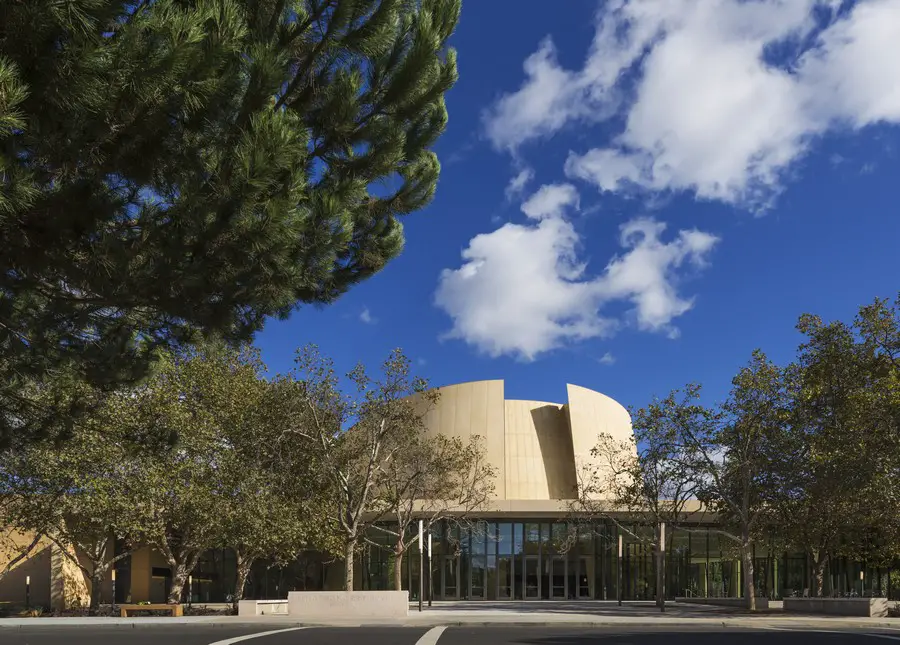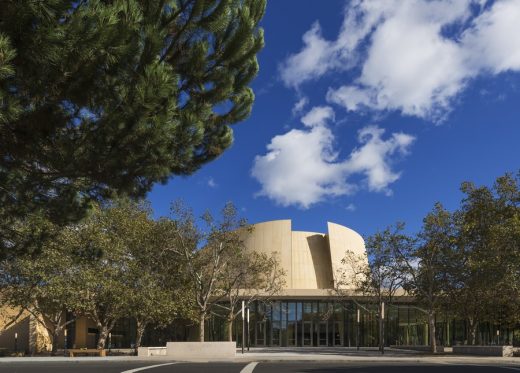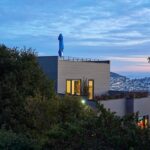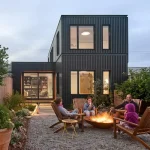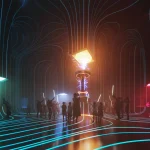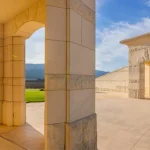Bing Concert Hall Stanford Campus, California Architecture, Building, USA, Architect
Bing Concert Hall : Stanford Campus Building
Concert Hall at Stanford, California – design by Ennead Architects
Jun 6, 2013
Bing Concert Hall, Stanford Campus
California, USA
Location: south of San Francisco
Design: Richard Olcott of Ennead Architects with Fisher Dachs Associates and Nagata Acoustics
Bing Concert Hall Honored with Awards for Design Excellence
STANFORD UNIVERSITY BING CONCERT HALL
DESIGNED BY RICHARD OLCOTT / ENNEAD ARCHITECTS
HONORED WITH AWARDS FOR DESIGN EXCELLENCE
New York, NY, June, 2013 – Awards of excellence honor the new Stanford University Bing Concert Hall designed by Richard Olcott of Ennead Architects. Ennead partners Olcott and Timothy Hartung led the design team, with lead acoustician Dr. Yasuhisa Toyota of Nagata Acoustics and theater consultants Bob Campbell and Joshua Dachs of Fisher Dachs Associates.
The state-of-the-art, 842-seat vineyard style concert hall opened in January. It exemplifies the seamless integration of architecture, acoustics and technology with the goal of transforming the practice, study and experience of the performing arts at Stanford and of Stanford Live, the University’s 43-year-old performing arts presenting organization.
The Society for College and University Planning (SCUP) and the American Institute of Architects Committee on Architecture for Education (AIA-CAE) have recognized Bing Concert Hall with a 2013 Award of Merit for excellence in comprehensive campus design and planning. Bing serves as a cornerstone of the Stanford Arts Initiative, a program developed to integrate arts across the University. Located at the east end of Museum Way, facing the Iris and B. Gerald Cantor Center for Visual Arts, the concert hall heralds the beginning of an even more comprehensive Stanford vision: the launch of an arts district that will offer easy access from downtown Palo Alto and the nearby highways. The SCUP 2013 Excellence in Architecture Awards ceremony will be July 29th at the Annual International Conference in San Diego, California, July 27-31.
Bing has also received a 2013 Design Award of Excellence from the California Council of the Society of American Registered Architects (SARACA). Established by the Society of American Registered Architects, the SARA Awards recognize design excellence and encourage client participation in achieving the best in the built environment. The Society’s highest award was presented May 18th in Palm Springs at SARACA’s annual awards celebration.
In addition to Bing Concert Hall, Olcott has designed three other projects at Stanford University: Iris and B. Gerald Cantor Center for the Arts (1998), Stanford Law School William H. Neukom Building (2011), and the Anderson Collection at Stanford University, set to open in summer 2014.
Bing Concert Hall Stanford Campus images / information from Ennead Architects
31 Jan 2013
Bing Concert Hall Building, Stanford Campus
CA, USA
Location: south of San Francisco
Design: Richard Olcott of Ennead Architects with Fisher Dachs Associates and Nagata Acoustics
Opening of Bing Concert Hall Designed By Richard Olcott/Ennead Architects
New York, NY, January 2013 – Audiences gathered on the campus of Stanford University to attend sold-out performances celebrating the January 11-13 opening weekend of the Bing Concert Hall. Designed by Richard Olcott of Ennead Architects, Bing Concert Hall exemplifies the seamless integration of architecture, acoustics and technology. The 842-seat vineyard style concert hall is the new hub for the arts at Stanford, a state-of-the-art venue attracting world-class musicians to the campus. Ennead partners Olcott and Timothy Hartung led the design team, with lead acoustician Dr. Yasuhisa Toyota of Nagata Acoustics and theater consultants Bob Campbell and Joshua Dachs of Fisher Dachs Associates.
The hall occupies an elliptical drum, which is encircled by an irregularly-shaped lobby – a transitional space that provides both physical and visual porosity to the exterior and offers a variety of possibilities for both formal and informal pre- and post-performance gatherings. Daylight fills the lobby from all sides: light wells strategically placed around the drum and the 19-foot-high glass and aluminum curtain wall blur the distinction between inside and out. Full-height sliding sections of the curtain wall open the facade to exterior colonnades, which are a contemporary expression of a traditional Stanford typology.
“There was a desire on everyone’s part to bring the landscape into the building and make it feel like you were going to a clearing in the woods to hear a concert and not walking up to an urban building with hard edges. We tried hard to erode all the edges and make them more permeable.” says Olcott.
Nestled within a 12-inch-thick concrete enclosure, the hall is acoustically isolated from exterior sounds and designed for optimal acoustics from every seat in the house. Terraced seating sections ring a 3,200-square-foot stage, a configuration that creates a warm and rich environment for both audience and performers. With the maximum distance of any seat only seventy-five feet from the stage, concertgoers experience a unique intimacy resulting from their proximity to the musicians and other concertgoers.
The hall achieves an impressive sense of both intimacy and grandeur, with its soaring 48-foot-high ceilings and elegant, supple lines. “We looked at the science of sound and likened it to textures and curves, looking at imagery of water and rippling landscape, sand dunes, clouds – there are no straight lines, just organic shapes,” Olcott explains. “Everything was done with the acoustics in mind – all materials selected, all profiles designed to provide the optimal acoustic experience.”
Each seating section has a unique and intimate feel, embraced by low walls that are angled and articulated with beech wood, whose specific density and textured surfaces strategically reflect and disperse sound. The center-section seating begins at the same level as the stage, which has six moving platforms and is built of Alaskan Yellow Cedar selected for its softness and superior resonant properties.
Contrasting with the material quality of the patron and performer level of the hall are the sail walls and ceiling cloud, whose lighter tones imbue the upper region of the hall with an uplifting quality. The large, sculptural, convex-shaped sails surround the seating defining the hall’s volume. These acoustic reflectors are carefully shaped and angled to provide superior optimal acoustic reflection or absorption. The sails not only serve the acoustics and provide architectural expression but can be used as screens for video projection.
Forty-eight feet above the stage floats a double-curved ceiling reflector, which houses and carefully disguises most of the technical lighting, rigging and sound support equipment. All wall and ceiling reflectors have been constructed to meet specific density requirements, and their surface articulation assists in deflecting sound. Between the sails, variable acoustic curtains allow for tuning the room to better accommodate performances that include amplified sound.
As Geoff Nutall of the St. Lawrence String Quartet states, “In the end, it’s about what it sounds like and the sound is devastatingly good…and the cool realization is that we can get better by listening to each other in this space.” Michael Tilson Thomas, music director of the San Francisco Symphony orchestra performed opening night: “It was so exciting. We had a lot of clarity and ability to really discern the quality of each section of the orchestra. We look forward to having more time to exalt in this beautiful space.”
Bing Concert Hall is a major milestone of the Stanford Arts Initiative, a university-wide effort to place the arts at the heart of a Stanford education. It faces the Anderson Collection at Stanford University, another Ennead project led by Olcott and Hartung, set to open in summer 2014. It is sited prominently next to Ennead’s Iris and B. Gerald Cantor Center for Visual Arts (1998). Along with Olcott’s Stanford Law School William H. Neukom Building, which opened in May 2011, this marks the fourth project for Olcott and Ennead at Stanford University.
Bing Concert Hall Building : further information on this major Stanford Campus, project
Bing Concert Hall, Stanford Campus information from Stanford
Location: Bing Concert Hall, Stanford University, North California, USA
New Architecture in San Francisco
Contemporary San Francisco Architecture
San Francisco Architectural Designs – chronological list
San Francisco Architectural Walking Tours by e-architect
San Francisco Architecture Offices – architecture firm listings on e-architect
Snøhetta
SFMOMA Expansion
Ennead Architects
Stanford University Building
Gensler, Architects
San Francisco International Airport
Foster + Partners with Arup
Apple Campus 2
Studio Libeskind
Contemporary Jewish Museum San Francisco
Rafael Viñoly Architects
Ray and Dagmar Dolby Regeneration Medicine Building
California Architecture : images
American Architecture : major developments + designs
Comments / photos for the Bing Concert Hall Building – Stanford Campus Architecture page welcome

